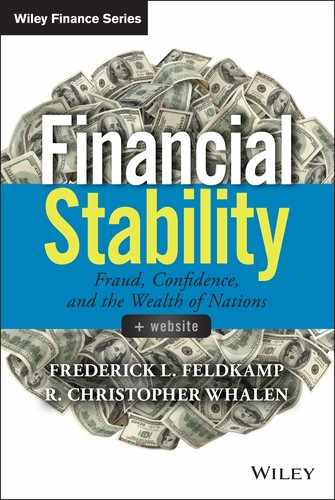CHAPTER 23
Managing the Water Balloon
The world of finance is the sum total of Earth’s capital resources and can be both measured and observed as liquidity inside an earthly balloon.
Within a water balloon, each and every push on the balloon has consequences that generate an equal and opposite reaction somewhere else on the balloon’s surface. When consequences fail to appear, or appear unequally, there is a need to dig deeper.
Prior to every financial crisis in world history, investors became convinced (through ignorance or deceit) that vast sums of new liquidity had somehow burst into existence without negative consequence (or as irrational exuberance with indefinite consequence). During the years leading up to the crisis of 2007–2009, people with great financial expertise (e.g., Alan Greenspan) were lulled into complacency as the world expanded a $67 trillion bubble through fraudulent off-balance sheet liabilities and shadow banking until that bubble burst with horrific consequences that may continue to restrain essential growth for a sustained period into the future.
It is safe to assume that any period during which spreads are sustained at a level of equilibrium that is near or below the complete-market range requires further examination (see, again, Charts 9.1, 9.2, and 9.3). When no logical explanation exists for this phenomenon (for example, a level playing field on which entities with no government support actively and transparently maintain equilibrium by trading risk-free financial arbitrage securities), it is safe to assume systemic fraud of some sort exists, which must be contained or a crisis will follow.
Responding to spread changes that are tracked daily and correlated with the events of each day will, eventually, provide the means for fixing just about every policy mistake that creates a crisis.
Successfully managing Earth’s water balloon of financial liquidity can be achieved by the same process of daily correction that statistical analysis brings to every successful productive business enterprise. Folly, created by an incapacity for empathy and common woodenheadedness (whereby change is a four letter word), is the demon that precludes the adjustments necessary for sustained financial stability.
We should acclaim those who, in 2005, gave U.S. investors the means to follow the daily race among holders of bonds—either toward or from risk. Unfortunately, it was only after investors’ near-total abandonment of U.S. risk in 2008 that our leaders finally found the necessary empathy and listened to minds unhampered by an excess amount of wood (most notably, Messrs. Bernanke and Kohn).
On the other hand, the U.S. experience in 2008 also establishes that it is never too late to change course. While the law of compound interest means that there is always a cost of delay, ending folly is what always leads to recovery.
In 2008, U.S. electors dumped a group of leaders that had converted an economy expanding wealth at a pace of more than $4 trillion per year to one that shrank wealth at the rate of more than $17 trillion per year. In the end, even those that had decimated worldwide economic health by their stubborn lethargy changed course. By the time they’d changed course, however, about $14 trillion of the $21 trillion per annum damage had occurred and the path to a worldwide potential loss of $67 trillion was set. The risk factors that led to the rest of the loss had been put in play.
The cost of knocking wood out of the heads of democratically elected leaders should never be that great, but history offers little consolation to those who wish for improvement. In her award-winning histories of woodenheaded folly (The March of Folly: From Troy to Vietnam), Barbara Tuchman notes that the scales of history are far more heavily weighted toward inertia than change.
Fear that the crisis of 2008 will recur (or that proposed reforms, such as risk retention, will only generate a new form of the same disease) continues to inhibit growth in the United States and around the world. Never in history, however, has a return to growth been achieved so quickly after experiencing an episode of systemic debt-contraction deflation. The Dutch tulip mania did not impact the banking system directly, but it still took seven years and debt forgiveness to finally regain substantive growth as affected groups ventured back into private-sector risk investments.
What’s left in the United States today is largely up to Congress, under the terms of the U.S. Constitution. We need mortgage forgiveness and document reconciliation, but only Congress can achieve that. We need new infrastructure development, improved health care, reform of income tax policies and the financial system, enlightened immigration policies, and human rights advances—and all must be accomplished with responsible long-term limits on unproductive speculation (there should be no limit on productive borrowing and spending; it generates more revenue than it costs).
All of these are within the exclusive legislative powers granted to Congress by the U.S. Constitution. Unlike in seventeenth-century Holland, our Constitution does not allow for a king who can decree debt forgiveness. In the United States, debt forgiveness can only be permitted through Congress enacting changes to uniform bankruptcy laws.
Managed properly, the world’s capital-sustaining water balloon has no size limit. We can, therefore, achieve whatever productive investment needs mankind wants. Proper management, however, assumes the capacity to overcome evil and folly. The path to sustained financial stability is clear, but can mankind follow the path?
